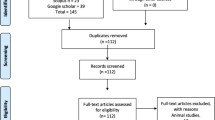Summary
Previously noted but undocumented observation of distal displacement of the left subclavian artery in patients with discrete coarctation of the aorta was verified by an objective two-dimensional echocardiographic method in 28 patients with aortic coarctation and in 43 control subjects.
Relative position of brachiocephalic arteries to one another was evaluated by the ratio of the distance between the left common carotid and the left subclavian artery to the distance between the innominate and the left common carotid artery.
Large distance between the left common carotid and the left subclavian artery was reflected by high value of the derived ratio. In neonates with aortic coarctation, the ratio was 1.69, SD±0.66, compared to 1.04, SD±0.40 in the control group. In older children this ratio was less discriminatory.
We also observed that the left subclavian artery formed an acute angle (<90°) with the proximal (upstream) segment of the aortic arch in infants with aortic coarctation. In all control infants, this angle was equal to or greater than 90°.
A corresponding necropsy study confirmed the echocardiographic findings.
We conclude that distal displacement of the left subclavian artery is associated with coarctation of the aorta. It can be accurately visualized and objectively assessed by the two-dimensional echocardiographic technique proposed.
Similar content being viewed by others
References
Bosniak MA (1964) An analysis of some anatomic-roentgenologic aspects of the brachiocephalic vessels.AJR 91: 203–209
Bremer JL (1948) Coarctation of the aorta and the aortic isthmuses.Arch Pathol 45:425
Bruins CL (1973) De arteriele pool van het hart. Heart, blood flow and great arteries. Thesis Leiden: JJ Groen en Zoon
Duncan WJ, Ninomiya K, Cook DH, Rowe RD (1983) Noninvasive diagnosis of neonatal coarctation and associated anomalies using two-dimensional echocardiography.Am Heart J 106:63–69
Edwards JE (1968) Aortic arch system. In: Gould SE (ed)Pathology of the heart and blood vessels. Charles C. Thomas, Springfield, Illinois, pp. 416–456
George B, DiSessa TG, Williams R, Friedman W, Laks H (1987) Coarctation repair without cardiac catheterization in infants.Am Heart J 114:1421–1425
George L, Waldman JD, Kirkpatrick SE, Turner SW, Pappelbaum SJ (1982) Two-dimensional echocardiographic visualization of the aortic arch by right parasternal scanning in neonates and infants.Fediatr Cardiol 2:277–280
Glancy DL, Morrow AG, Simon AL, Roberts WC (1983) Juxtaductal aortic coarctation. Analysis of 84 patients studyied hemodynamically, angiographically and morphologically after age 1 year.Am J Cardiol 51:537–551
Houston AB, Simpson IA, Pollock JCS, Jamieson MPG, Doig WB, Coleman EN (1987) Doppler ultrasound in the assessment of severity of coarctation of the aorta and interruption of the aortic arch.Br Heart J 57:38–43
Huhta JC, Gutgesell HP, Latson, LA, Huffines FD (1984) Two-dimensional echocardiographic assessment of the aorta in infants and children with congenital heart disease.Circulation 70:417–424
Lappen RS, Muster AJ, Duffy CE, Berdusis K, Paul MH (1986) Predictability of coarctation of the aorta from the degree of transverse aortic arch hypoplasia: An echocardiographic-angiographic correlation.Pediatr Cardiol (Proceedings of the Second World Congress). Springer-Verlag, New York, pp 172–174
Morrow R, Huhta JC, Murphy D, McNamara DG (1986) Quantitative morphology of the aortic arch in neonatal coarctation.J Am Coll Cardiol 8:616–620
Nihoyannopoulos P, Karas S, Sapsford RN, Hallidie-Smith K, Foale R (1987) Accuracy of two-dimensional echocardiography in the diagnosis of aortic arch obstruction.J Am Coll Cardiol 10:1072–1077
Simpson IA, Sahn DJ, Valdes-Cruz LM, Chung KJ, Sherman FS, Swensson RE (1988) Color Doppler flow mapping in patients with coarctation of the aorta: New observations and improved evaluation with color flow diameter and proximal acceleration as predictors of severity.Circulation 77:736–744
Smallhorn JF, Huhta JC, Adams PA, Anderson RH, Wilkinson JL, Macartney FJ (1983) Cross-sectional echocardio-graphic assessment of coarctation in the sick neonate and infant.Br Heart J 50:349–361
Wilson N, Sutherland GR, Gibbs JL, Dickinson DF, Keeton BR (1989) Limitations of Doppler ultrasound in the diagnosis of neonatal coarctation of the aorta.Int J Cardiol 23:87–89
Author information
Authors and Affiliations
Rights and permissions
About this article
Cite this article
Kantoch, M., Pieroni, D., Roland, J.A. et al. Association of distal displacement of the left subclavian artery and coarctation of the aorta. Pediatr Cardiol 13, 164–169 (1992). https://doi.org/10.1007/BF00793949
Issue Date:
DOI: https://doi.org/10.1007/BF00793949




